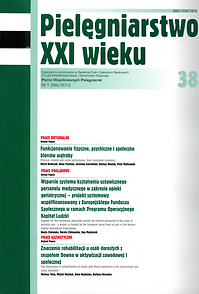Boosters as psychosocial risky problem to children and teenagers mith and reality
Keywords:
boosters, drugs, teenagers addiction, condimentsAbstract
BOOSTERS AS PSYCHOSOCIAL RISKY PROBLEM TO CHILDREN AND TEENAGERS MITH AND REALITY
Over the last years Poland has witnessed a great growth in shops called smart shops which offer various substances of natural type such as herbal blends – “Spice” and synthetical ones. Besides the shops are full of accessories ranging from different pipes to various cigarette - holders. Moreover, there appear an increasing number of amateurs of these matters. The above factors have contributed significantly to carring out a deep analysis of facts and miths concerning the boosters.
Lack of a sound knowledge on this topic, more frequent information about the users hospitalization and poisoning leading to death have caused a feeling of fear and anxiety.
The term “boosters” is not classified as a medical explanation but it is simply a commonly used concept. In Poland this term refers to different substances which involve psychoactive matters of both natural and synthetical origin with stimulating, psychodelic or hallucinogenic actions. Until recently these substances have not been listed among the preparations under the pharmaceutical control as an annex to a bill against drug addiction.
Today in our country one of the main problems with a psychosocial character which endanger children, teenagers and their parents is created by using the so called boosters.
Aim. The main objective of this work was a theoretical analysis of facts and miths with regard to the use of the above-mentioned matters in Poland allowing for healthy, social and legal aspect.
References
1. Warecki K. Dopalacze. Radom: Polskie Wydawnictwo Encyklopedyczne; 2010.
2. Malanowski M, Gruszczyńska D. „Dopalacze” a system. Terapia. 2011; 1: 27-28.
3. Woźniak PA, Olędzka-Oręziak M. „Dopalacze” – jak nie przeoczyć rozpoznanie. Nowa Klinika. 2011; 18 (5): 5104-5113.
4. Kidawa M. Dopalacze. Terapia. 2009; 1: 31-34.
5. Gorzkowska I, Samochowiec J. Zespół hyperkinetyczny (ADHD) a uzależnienia. Terapia. 2008; 5: 4-8.
6. Bilikiewicz A. red. Psychiatria Podręcznik dla studentów medycyny. Warszawa: Wydawnictwo Lekarskie PZWL; 2006.
7. Scully JH red. Psychiatria. Wrocław: Wydawnictwo Medyczne Urban & Partner; 1998.
8. Kandel I. Program terapeutyczny dla pacjentów z podwójną diagnozą nadużywających substancji psychoaktywnych. Psychiatria Polska. 2007; XLI (5): 727-736.
9. Heitzman J. red. Psychiatria. Warszawa: Wydawnictwo Lekarskie PZWL; 2007.
10. Compton MT, Ramsay CE. Wpływ używania konopi indyjskich na wiek wystąpienia objawów prodromalnych i psychotycznych. Psychiatria po dyplomie. 2009; 6 (5): 10-16.
11. Dudek D. Nowe narkotyki nowe zagrożenia. Terapia. 2008; 2: 30-33.
12. Piekoszewski W, Florek E. Dopalacze. Przegląd Lekarski. 2009; 66 (10): 861-864.
13. Raby WN. Nadużywanie kanabinoidów w przebiegu psychoz: strategie terapeutyczne. Psychiatria po dyplomie. 2009; 6 (5): 29-33.
14. Ross S. Ketamina a uzależnienie. Psychiatria po dyplomie. 2009; 6 (2): 44-50.
Downloads
Published
Issue
Section
License
Copyright (c) 2012 Tadeusz Paweł Wasilewski (Autor)

This work is licensed under a Creative Commons Attribution 4.0 International License.




